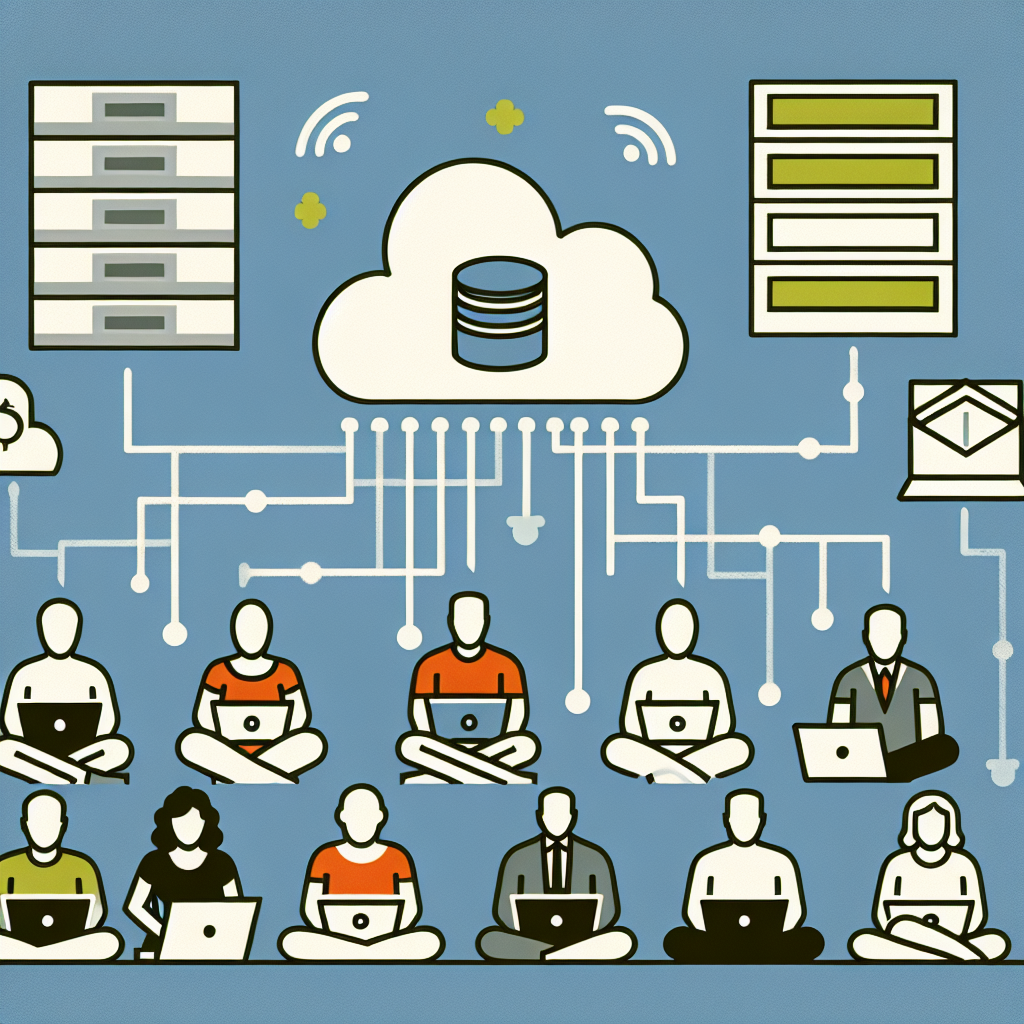Cloud computing has revolutionized the way organizations, including non-profits, manage and store their data. By utilizing remote servers hosted on the internet, non-profit organizations can access, store, and share information more efficiently and securely than ever before. This innovative technology allows non-profits to streamline their operations, collaborate with stakeholders, and mobilize resources with ease. In this digital age, embracing cloud computing is crucial for non-profit organizations looking to maximize their impact and reach. Join us as we explore the countless benefits and opportunities that cloud computing offers for non-profit organizations.
Understanding Cloud Computing
Cloud computing refers to the delivery of computing services over the internet. Instead of organizations managing their own physical servers and infrastructure, they can access computing resources, such as storage, databases, networking, software, and analytics, on a pay-as-you-go basis from a cloud provider.
Key characteristics of Cloud Computing:
– On-Demand Self-Service: Non-profit organizations can provision computing resources as needed without human interaction with the service provider.
– Broad Network Access: Cloud services are accessible over the internet from various devices, providing flexibility and scalability.
– Resource Pooling: Cloud providers serve multiple organizations, sharing resources to achieve economies of scale and efficiency.
– Rapid Elasticity: Non-profits can quickly scale their resources up or down based on demand, paying only for what they use.
– Measured Service: Cloud computing resources are monitored, controlled, and reported, allowing organizations to optimize their usage and costs.
Benefits of Cloud Computing for non-profit organizations:
– Cost-Effective: Cloud computing eliminates the need for upfront investments in hardware and infrastructure, reducing capital expenses for non-profits.
– Scalability: Organizations can easily scale their computing resources based on workload fluctuations or growth without significant investments in new hardware.
– Flexibility: Cloud services offer a variety of options, allowing non-profits to choose the services that best meet their needs and adjust as necessary.
– Accessibility: Cloud computing enables remote access to data and applications, facilitating collaboration among distributed teams and volunteers.
– Security: Cloud providers often have robust security measures in place to protect data, offering non-profits a level of security that may be challenging to achieve on their own.
Implementing Cloud Computing for Non-Profits

Assessing the needs of non-profit organizations
In the process of implementing cloud computing for non-profit organizations, it is crucial to conduct a thorough assessment of their specific needs and requirements. This involves understanding the nature of their operations, the volume of data they handle, their budget constraints, and the level of technical expertise available within the organization. By conducting a comprehensive needs assessment, non-profits can identify the areas where cloud computing can bring the most value and efficiency gains.
Selecting the right cloud service provider
Choosing the right cloud service provider is a critical step in the implementation process for non-profits. Factors to consider when selecting a cloud service provider include the provider’s reputation, security measures, compliance certifications, scalability of services, and cost-effectiveness. Non-profits should prioritize providers that offer tailored solutions for the non-profit sector, with features such as discounted pricing or donation programs.
Planning for migration to the cloud
Migration to the cloud requires careful planning to ensure a smooth transition without disruptions to the organization’s daily operations. Non-profits should develop a comprehensive migration plan that outlines the timeline, data migration strategy, training for staff members, and contingency measures in case of any unforeseen issues. It is essential to communicate the migration plan effectively to all stakeholders and ensure that there is support available throughout the transition process.
Factors to Consider when Choosing a Cloud Service Provider
When non-profit organizations are considering implementing cloud computing services, selecting the right cloud service provider is crucial for ensuring the success and efficiency of their operations. Several key factors need to be taken into account when choosing a cloud service provider:
Security measures in place
- Data Encryption: Ensure that the cloud service provider offers robust data encryption mechanisms to protect sensitive information stored in the cloud.
- Access Control: Look for providers that offer strong access controls, including multi-factor authentication and role-based access, to prevent unauthorized access to data.
- Compliance Certifications: Verify that the cloud service provider complies with relevant data protection regulations and industry standards to maintain data security and privacy.
Scalability of services
- Resource Availability: Assess the provider’s ability to scale resources up or down based on the non-profit organization’s changing needs, ensuring flexibility and cost-effectiveness.
- Performance Guarantees: Look for service level agreements (SLAs) that guarantee performance levels and uptime to support the organization’s operations without disruptions.
- Integration Capabilities: Consider the provider’s compatibility with existing systems and applications to facilitate seamless integration and scalability.
Cost-effectiveness
- Transparent Pricing: Seek cloud service providers that offer transparent pricing models with clear breakdowns of costs to avoid unexpected expenses.
- Resource Optimization: Evaluate the provider’s resource optimization strategies to minimize costs while maximizing the efficiency of cloud services.
- Non-Profit Discounts: Inquire about any discounts or special pricing options available for non-profit organizations to make the cloud services more affordable and sustainable.

Impact of Cloud Computing on Non-Profit Operations
Cloud computing has revolutionized the way non-profit organizations operate, providing them with advanced tools and capabilities to enhance their efficiency and effectiveness in achieving their missions. The impact of cloud computing on non-profit operations can be seen in the following key areas:
Streamlining Communication and Collaboration
- Cloud computing enables non-profits to communicate and collaborate more effectively, breaking down barriers of time and location. Through cloud-based email services, video conferencing platforms, and project management tools, teams can work together seamlessly regardless of their physical location.
- Real-time collaboration on documents through cloud-based productivity suites like Google Workspace or Microsoft 365 allows team members to work on the same files simultaneously, fostering greater teamwork and productivity.
- Centralized communication channels in the cloud ensure that all stakeholders have access to the latest information and updates, reducing the likelihood of miscommunication and ensuring alignment across the organization.
Enhancing Data Management and Analysis
- Non-profits deal with vast amounts of data related to donors, beneficiaries, programs, and operations. Cloud computing provides them with secure and scalable storage solutions to effectively manage and analyze this data.
- Cloud-based databases and analytics tools empower non-profits to gain valuable insights from their data, such as donor behavior trends, program impact assessments, and operational efficiencies.
- With cloud-based data management systems, non-profits can ensure data security and compliance with regulations, safeguarding sensitive information and building trust with stakeholders.
Improving Accessibility to Resources
- Cloud computing levels the playing field for non-profits by providing access to sophisticated resources that were once only available to large corporations. Through cloud-based software applications and platforms, non-profits can automate manual processes, optimize workflows, and drive innovation.
- The scalability of cloud services allows non-profits to adjust their resource usage based on their current needs, avoiding the costs and limitations of traditional on-premises infrastructure.
- Cloud-based fundraising and donor management tools empower non-profits to reach a wider audience, engage with supporters more effectively, and track financial contributions in real-time, ultimately enhancing their fundraising efforts and financial sustainability.
In conclusion, the impact of cloud computing on non-profit operations is profound, enabling organizations to operate more efficiently, make data-driven decisions, and maximize their impact on the communities they serve. By embracing cloud technology, non-profits can stay agile, resilient, and focused on their mission of creating positive social change.
Examples of Successful Cloud Integration in Non-Profit Organizations
- Case study 1: Increased efficiency in fundraising efforts
In a non-profit organization focused on environmental conservation, the integration of cloud computing solutions facilitated a more streamlined approach to fundraising. By utilizing cloud-based donor management systems, the organization was able to centralize donor information, track contributions more effectively, and personalize communication with supporters. This led to a significant increase in fundraising efficiency, as staff members could easily access donor data, analyze giving patterns, and tailor fundraising campaigns based on donor preferences. As a result, the organization experienced a boost in donation levels and forged stronger relationships with its supporters.
- Case study 2: Improved volunteer coordination
Another non-profit organization dedicated to providing educational resources to underserved communities leveraged cloud computing to enhance volunteer coordination efforts. By adopting a cloud-based project management tool, the organization could efficiently assign tasks, communicate with volunteers, and track project progress in real-time. This improved coordination among volunteers, staff members, and project beneficiaries, leading to more effective delivery of services and programs. Additionally, the cloud-based platform enabled volunteers to access resources remotely, collaborate on projects seamlessly, and provide feedback on their experiences. Consequently, the organization saw an increase in volunteer engagement, retention rates, and overall impact in the communities it served.
Overcoming Challenges in Cloud Adoption
In the realm of non-profit organizations, cloud computing offers a plethora of benefits, ranging from cost-efficiency to enhanced collaboration. However, the adoption of cloud technology is not without its challenges. Three key hurdles that non-profits commonly face in this regard include addressing data security concerns, ensuring compliance with regulations, and training staff for cloud utilization.
Addressing Data Security Concerns
Data security is paramount for non-profit organizations, given the sensitive nature of the information they handle. When transitioning to the cloud, ensuring robust security measures is essential to safeguard data against potential breaches or unauthorized access. Non-profits must work closely with cloud service providers to implement encryption protocols, access controls, and regular security audits to mitigate risks and protect sensitive data.
Ensuring Compliance with Regulations
Non-profit organizations are often subject to various regulatory requirements, such as data protection laws or industry-specific compliance standards. Moving data and operations to the cloud necessitates adherence to these regulations to avoid legal repercussions. Non-profits must conduct thorough assessments to ensure that their cloud service provider complies with relevant regulations and that proper data handling procedures are in place to maintain compliance at all times.
Training Staff for Cloud Utilization
Transitioning to cloud computing involves a shift in the way non-profit organizations manage their data and workflows. To maximize the benefits of cloud technology, staff members need to be adequately trained on how to effectively utilize cloud-based tools and platforms. Providing comprehensive training programs, workshops, and resources can empower employees to leverage cloud solutions to streamline processes, enhance collaboration, and drive organizational efficiency.
By proactively addressing data security concerns, ensuring compliance with regulations, and investing in staff training for cloud utilization, non-profit organizations can overcome the challenges associated with adopting cloud computing and unlock the full potential of this transformative technology.
Best Practices for Secure Cloud Implementation
Implementing cloud computing for non-profit organizations can greatly enhance efficiency and collaboration among staff members and stakeholders. However, ensuring the security of sensitive data and information is paramount in the cloud environment. To mitigate risks and maintain a secure cloud infrastructure, non-profit organizations should adhere to the following best practices:
-
Regular data backups: Regularly backing up data is essential to prevent data loss in case of system failures or cyber attacks. Non-profit organizations should establish automated backup processes to ensure that data is consistently and securely stored in multiple locations.
-
Multi-factor authentication: Implementing multi-factor authentication adds an extra layer of security to cloud accounts by requiring users to provide multiple forms of verification before accessing sensitive information. This additional step helps prevent unauthorized access and enhances overall data protection.
-
Staff awareness programs on cybersecurity: Educating staff members about cybersecurity best practices is crucial in maintaining a secure cloud environment. Non-profit organizations should conduct regular training sessions to raise awareness about potential threats, such as phishing scams and malware attacks, and provide guidelines on how to securely handle data in the cloud.

By incorporating these best practices into their cloud implementation strategy, non-profit organizations can effectively safeguard their data and operations while reaping the benefits of cloud computing technology.
Future Trends in Cloud Computing for Non-Profits
In the ever-evolving landscape of technology, non-profit organizations are increasingly turning to cloud computing to streamline their operations and enhance their impact. Looking ahead, several key future trends are expected to shape the use of cloud computing in the non-profit sector:
- Integration of AI and Machine Learning:
-
Non-profits are anticipated to leverage the power of artificial intelligence (AI) and machine learning algorithms within cloud platforms to gain valuable insights from their data. By harnessing these technologies, organizations can enhance their decision-making processes, personalize donor interactions, and optimize resource allocation for maximum impact.
-
Expansion of Mobile Cloud Services:
-
As mobile devices continue to play a pivotal role in how people access information and engage with organizations, the integration of mobile cloud services is set to expand for non-profits. This trend will enable greater flexibility and accessibility, allowing staff and volunteers to collaborate effectively regardless of their location. Moreover, mobile cloud services can facilitate real-time data collection in the field, improving response times and overall efficiency.
-
Continued Focus on Data Privacy and Protection:
- With data security becoming an increasingly critical concern, non-profit organizations will continue to prioritize robust measures for safeguarding sensitive information stored in the cloud. This includes implementing encryption protocols, multi-factor authentication, and regular security audits to mitigate the risks of cyber threats and data breaches. Strengthening data privacy practices not only fosters trust among donors and beneficiaries but also ensures compliance with evolving regulations such as the General Data Protection Regulation (GDPR).
FAQs: Cloud Computing for Non-Profit Organizations
What is cloud computing and how can it benefit non-profit organizations?
Cloud computing refers to the delivery of computing services such as storage, databases, software, and networking over the internet. For non-profit organizations, cloud computing can help reduce IT costs by eliminating the need for expensive hardware and software licenses. It also allows for remote access to data and applications, boosting collaboration among team members regardless of their location.
How secure is cloud computing for non-profit organizations?
Cloud computing providers invest heavily in security measures to protect their customers’ data. Non-profit organizations can benefit from advanced security features such as encryption, firewalls, and multi-factor authentication provided by reputable cloud service providers. It is essential for organizations to choose a trusted cloud provider and implement best practices to safeguard their data.
Can non-profit organizations scale their operations easily with cloud computing?
Yes, one of the key benefits of cloud computing is scalability. Non-profit organizations can easily scale up or down their computing resources based on their needs. This flexibility allows organizations to adapt to changing demands without having to invest in additional hardware or infrastructure. Cloud computing also enables nonprofits to quickly deploy new applications and services to support their mission.
How can cloud computing help non-profit organizations with disaster recovery and data backup?
Cloud computing provides non-profit organizations with reliable disaster recovery and data backup solutions. Organizations can store their data on cloud servers, ensuring that it is protected from physical damage and natural disasters. In the event of an emergency, nonprofits can quickly recover their data and resume operations with minimal downtime. Cloud-based backup solutions also automate the backup process, eliminating the need for manual backups.
What are some popular cloud computing services available to non-profit organizations?
There are several popular cloud computing services tailored for non-profit organizations, including Microsoft Azure for Nonprofits, Google for Nonprofits, and Amazon Web Services (AWS) for Nonprofits. These providers offer discounted or free cloud services to help nonprofits leverage the power of the cloud. Organizations can choose the right cloud service provider based on their specific needs and budget.